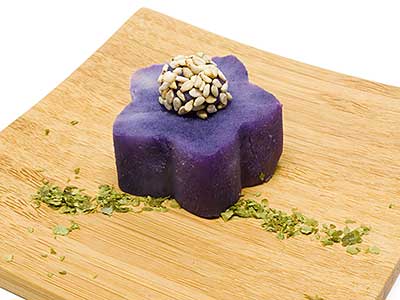June 17, 2013
Amuse-Bouche

pourpre de patate douce
(purple sweet potato)
Why would an otherwise normal 36-year-old woman rush out of her hotel room late at night in her nightgown to buy a sweet potato? Here’s what happened.
On November 8th, 1985, my wife and I checked into the Kyoto Central Inn for a three-night stay. This was day fifteen of an eighteen-day trip to Japan. It was my first trip to Japan, if you ignore the overnight layover I had near Narita in 1980. My wife had visited Tokyo a couple of times, but hadn’t traveled to Kyoto before. We had already visited Kyoto earlier on this trip, but then had stayed on the outskirts of town. Our new location gave us better access to sights in the center and was closer to the train station.
When we walked around the neighborhood during the day we noticed parking places that seemed to be used as storage for piles of piping, plastic buckets, and the like, all covered with a tarp. Walking around the same areas after dinner, we saw that food stalls now occupied these same parking spaces. The tarp was now the roof of the stall, and men were sitting under the cover eating various street foods. We also saw an occasional vendor pushing a cart, yelling out what he was selling as he walked along the sidewalk. I didn’t know what they were selling, but my wife, who speaks some Japanese, could understand some of the vendor’s cries.
So it was that on our first or second night in the room that my wife, hearing the cry of a pushcart vendor selling sweet potatoes, jumped out of her chair and threw on a long trench coat over her nightgown. Out the door she went with a few hundred yen in one hand and the room key in the other. A few minutes later, she returned with a foil-wrapped sweet potato that minutes before was cooking away in a bed of charcoal on the pushcart. The potato was quite hot, and she became frustrated waiting for it to cool. I just went to sleep, not understanding all the excitement. In the end, she gobbled half the potato that night and the remainder the next day as a snack.
So the question still remains, why would an otherwise normal 36-year-old woman rush out of her hotel room late at night in her nightgown to buy a sweet potato? My wife was raised in Hawaii. Her father worked in the fields on the sugar plantation, and her mother packed pineapple in the cannery. During the first part of her life, the family lived in housing provided by the sugar company. This was rural living in the middle of fallow fields, but they did have water, electricity, and sewage. One of the snacks of her childhood was boiled or steamed sweet potatoes. Not just any sweet potato, but purple-fleshed ones that had originated in Okinawa. These particular ones were grown by her father in the family garden. These potatoes were a real treat for the kids. This night in Kyoto was a chance for her to relive those days.
Nowadays, I can easily purchase Hawaiian-grown Okinawan sweet potatoes in local stores in California. They are more expensive than other sweet potatoes, but much better tasting. To make them edible, I just boil or steam them until they are tender. The specimen used for the preparation below was steamed until a meat fork was able to easily pierce it. I set the cooked sweet potato on a plate to cool, which took a couple of hours.
I after cooling, I cut off a piece of the potato, peeled it, and mushed it between my fingers. My originally idea included reshaping the sweet potato, but there was insufficient starch to hold the crumbled potato together. I didn’t want to add anything to bind it together. So I decided to use whole pieces.
I peeled the rest of the potato and cut it into thick slices. To make each slice a little fancier, I cut each further into a decorative shape with a Japanese vegetable cutter. For the little topknot, I used a 1-cm (3⁄8-in) baller to cut spheres from the scrap pieces. These I gently rolled in toasted, white sesame seeds, and placed on top of the slices. To round out the serving, a little ao-nori was sprinkled around the potato slices for decoration.
Note: Sweet potatoes other than Okinawan purple sweet potatoes could be used. If the potato has enough flavor, but is a lighter color, I would substitute black sesame seeds for the white ones. If the flavor of the sweet potato chosen, I’d replace the topknot by scooping a small indentation with the same-sized baller. I then fill the hole with a little syrup or thick soy sauce.
© 2013 Peter Hertzmann. All rights reserved.
